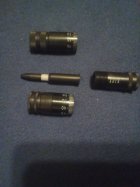That is the best "thingy" to use as a bump comparator where the datum line is an area, not a single point contact datum or slight larger single point bump insert!!!
This is the method, I developed using physical properties of brass to improve accuracy, I've been using for over 40 years for finding maximum headspace and limits of the brass for adjust bump on the sizing dies!!! AND, THERE IS NO NEED TO REMOVE THE EJECTOR FOR THIS TESTING PROCESS!! This is for a 6.5 PRC, using virgin ADG brass!! Find the maximum safe range in rifle breaking in and test using demiled Nosler brass!!! In the process, I determined the bump on the new ADG brass by random factory bump measurement and set the sizing die to the datum number 1.622 where most of the cases were slightly bumped!!! Loaded 2 round of each powder intervals!!! The last 2 cases were 0.2 grains over reloading manual max pressure!!!
Take a caliper with attracted bump comparator to the range!!! Before firing each round, use the comparator and record that datum length!!! Fire the round, measure the new datum length after cooling to ambient temperature , record, and record the velocity!!! HERE IS THE KEY!! Wait for that rifle to cold down with the bolt open for 3 to 5 minutes!!! In the meantime, record any changes in felt bolt lift, look at the previous fired case for pressure signs, measure and record the next round!! Fire the next round and keep reaping and recording while looking for pressure signs and changes in bolt lift on extraction!! The attachment is the records from that range test!!!
There is the load number, powder load weight, with two sets of columns, where each set of columns were the before bump, after fire bump, and the velocity!! The top big arrow, pointing to 3089 was the 1st slightly noticeable heavier bolt lift, the start of compression of the brass which is at 1.6265"!! The brass was fire formed from #4 and up in the table!!! The last fired load at 3120 exceeded full brass COMPRESSABLITY (0.0005 compression on the shoulder and 0.0005 on the base) with noticeably heavy bolt lift and a very, very slight extractor imprint on the filed base which I filed off lightly!!! The starting point load of severe overall case deformation, pressure well exceeding the tensile strength of the base brass region (another physical property)!!! The DESIGNED base has higher tensile strength due to its hardness compared to the softer shoulder and neck with lower tensile strength!!! This is why I don't anneal without a coolant bath to avoid softening below the 1/4" region below the body/shoulder junction!!! IMPROPER ANNEALING CAN LEAD TO CASE HEAD SEPARATION, LOWER BODY BLOATING (Clickers), AND/OR PRIMER POCKET WALL SWELLING (Lose primers) IF HEAT IS ALLOWED TO FLOW TO THE LOWER BODY!!! OVER PRESSURE CAN CAUSE THESE SAME ISSUES!! Staying under 3100 will almost eliminate deformation at and under the stretch zone at 0 Bump!!! Find the minimum load to achieve full fire formation is needed with Bump >=1 town reduce deformation due to the hammering affect of the base slamming into the boltface!!! That is your max safe load for case longevity!!!
From the data, the slight compression (approximately 0.00025" on both the shoulder and the base) on the full length fire formed cases is my desired load at 62.9grains of powder to finish fire forming the rest ADG brass!! Now, I adjust the die till I have 1.6265 and have a slightly heavy bolt drop at the tail end of the bolt lug cam stroke and the case, under compression (firmly and rigid) which will center the base and the double centering of the two tapers, aligning the bullet, near perfect, to the rifling!!!! Once and done setting of the die for that rifle using the old Bonanza coax press!!! I put one case in the die box for checking the comparator because the chamber should not change under normal conditions!!! THAT ONE CASE IN THE DIE BOX IS THE CHEAP, FIXED BUMP GAUGE!! For you target and hunter shooters, set you bump by subtracting the desired set back of the shoulder and adjust the die using the CASE IN THE DIE BOX for a reference to the true headspace of the chamber!!
I will retest for the Lapau virgin 6.5 PRC cases due to their probable differences in physical properties!!!! Once I find the differences of tensile strength at the base, the higher tensile brand cases will be used for high pressure/velocity hunting loads!! The lower tensile brand will be used for lower pressure/lower velocity target and plinking!!! Just need to know the limits of the two brands!!!!











